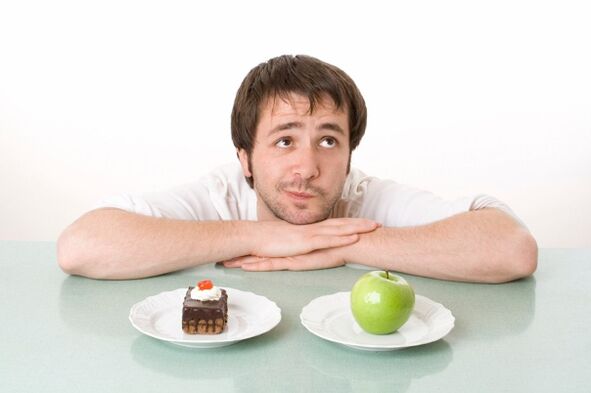
In fact, it is not difficult to prepare food for diabetics, we are not talking about special diets. In type 1 and type 2 diabetes mellitus, an important role is played by a balanced diet, which is suitable not only for sick people, but also for healthy people.
No.
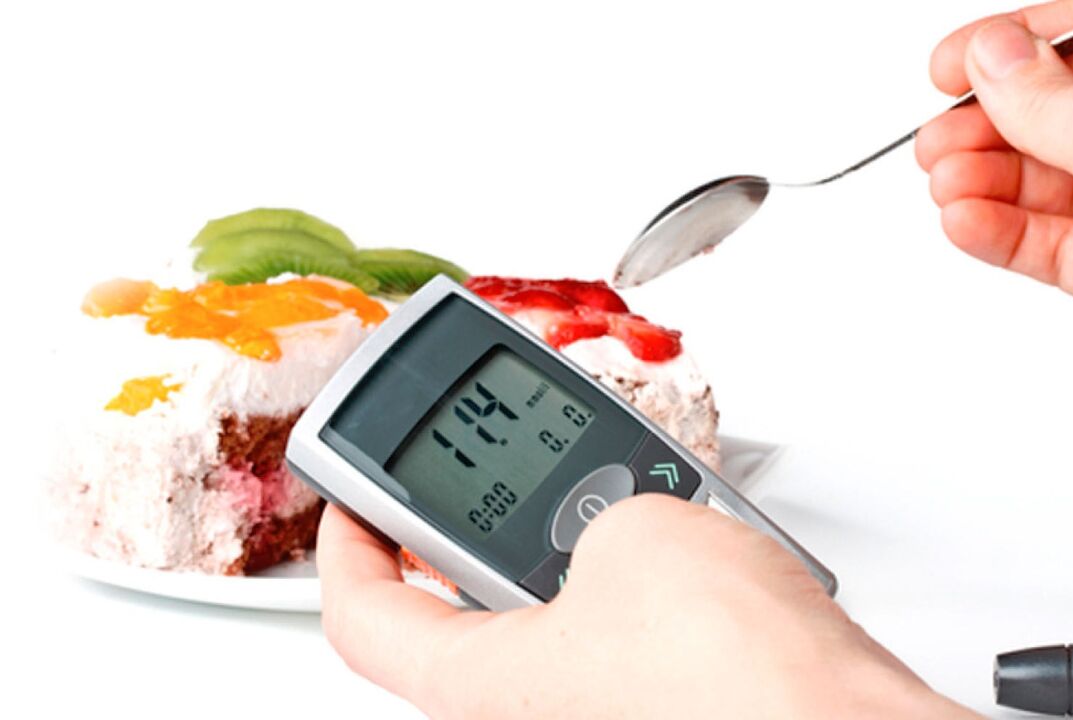
The first fact is that the diabetes mellitus diet involves limiting all sugars directly: diabetes mellitus dishes (first, second and even desserts) without sugar or honey, sweet foods excluded - cakes, ice cream, desserts (apple pie, fruit pudding). , pancakes, etc. ), biscuits, sweets, cakes, chocolates, sugary drinks and juices, etc. , fatty and fried foods, fatty meats and sausages, beer, alcohol, white or black bread (usually caramel added to it) and any products made from white flour.
In addition, dried fruits, grapes, plums and pears should be completely avoided. With regard to alcoholic beverages, exclude beer, drink only dry wine, up to 200 ml per day, drink strong alcoholic beverages only as a last resort, and very pure. Remember to include alcohol in your daily calorie intake.
yes
Just eat whole grain bread. The meat can be cooked, but exclusively, lean!
Be careful with side dishes, if you want to cook dumplings or dumplings, don’t forget to keep track of portion sizes. Rice, pasta, potatoes are more suitable.
For diabetes, recipes should include vegetables (which should also be eaten raw) as they contain vitamins, minerals, protein and almost no (or minimum) sugar. Instead of vegetables, you should limit carrots, beans and corn. Fruits can be eaten at most once a day, best as a morning snack.
It is advisable to divide food into 4-6 small meals a day, make light snacks in the evening. The recipe for diabetes mellitus and the amount of food should be chosen depending on whether your weight is in the normal range or there is a need to reduce it, as well as according to how much you move during the day.
For all diabetics, it is desirable and recommended to move at least 30 minutes a day; brisk walking, running, swimming, cycling, etc. works fine.
You need to take at least 10, 000 steps per day.
It is quite understandable that sometimes the dietary scheme will seem unbearable, and an irresistible desire to eat something from the "forbidden" will appear. Once a month, you can relax and indulge in dark chocolate (chocolate is ideal for cooking or that contains 60-70% cocoa).
If you decide to change your eating habits, you are recommended to first check with your doctor or specialist, such as a diabetic, about further adjustments to diabetes medications and insulin doses if given. It is advisable to carry out self -monitoring using a glucometer.
Dietary measures and regimens are indispensable (neither treatment, nor insulin, etc. ), and represent the foundation for successful treatment for all diabetics! This fact is confirmed by a large number of specialized scientific studies in our country and in the world.
Diet for diabetes
Prohibited products:
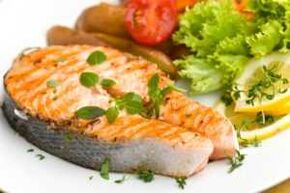
- Fatty dairy products.
- Yellow and its products.
- sausage.
- Fatty meats - goose, duck.
- Concentrated alcohol.
- Sugar free.
- candy.
- Salty snacks - chips, nuts, snacks, etc.
Recommended products:
- Fats - butter, margarine, milk and dairy products - are all low in fat.
- Meat - young animals (beef, pork, lamb, chicken, rabbit, turkey).
- Fish - freshwater and sea.
- venison.
- Ham - in small quantities.
- Vegetables - all kinds, including legumes.
- Fruit - in small quantities.
- The bread is wheat.
Technological methods that can be used are boiling, boiling, grilling, rarely - frying.
Below are some diabetic recipes, from soups and main courses to desserts, suitable for diabetics.
The amount of raw ingredients contained in the following diabetic recipe is designed for 4 servings.
Diet soup for diabetics
Soybean soup
Ingredients:
60 g soybeans, 20 g flour, 20 g butter, 20 g onion, garlic, parsley, salt.
Preparation:
Soybeans should be boiled until cooked or canned. Lather finely chopped onions in butter, add flour and add hot water. Simmer, add boiled soybeans, chopped garlic with salt and chopped parsley. Cooked soups are better eaten hot.
The main food of the diet for diabetics
flounder fried
Ingredients:
600 g flounder, 20 g butter, salt, bell pepper, 10 g of wheat flour, 1 lemon.
Preparation:
In wheat flour mixed with salt and pepper, wrap the fish parts, drizzle with oil and roast. Season the finished dish with lemon juice and garnish with lemon slices.
Curry
Ingredients:
320 g of meat (beef, beef, pork, rabbit, but the best of all - a variety), 200 g tomatoes, 40 g oil, 1 onion, 20 g potatoes, salt, parsley, marjoram, cumin.
Preparation:
Quickly fry the peeled meat cubes in oil and cover with hot water. Add salt, chopped tomatoes, peeled onions and bring to a boil. When the meat is almost tender, add the peeled raw potatoes, finely grated, finely chopped cumin and marjoram. Remove the onion from the finished stew (if it is boiled, then leave it) and add the finely chopped parsley.
Dietary vegetable dishes for diabetics
Stuffed tomatoes

Ingredients:
4 large hard tomatoes, 120 g chicken meat, 20 g rice, 20 g butter, 1 egg, salt.
Preparation:
Cut the top off the washed tomatoes and remove the middle part. Boil the washed rice in salted water, mix with the minced chicken, salt, add the beaten eggs and mix well.
Fill the prepared tomatoes without the middle part with the resulting mixture, cover it with the chopped top and place in a lightly oiled container. Add hot water and simmer, covered.
Boil the removed core, grind and put in a prepared dish.
Vegetable risotto
Ingredients:
160 g of rice, 20 g of carrots, 20 g of cauliflower, 15 g of celery, 15 g of parsley, 10 g of corn, oil, parsley, salt, 120 g of hard cheese.
Preparation:
Cut all the peeled vegetables into cubes or grate on a coarse grater. Cut the legs from the cauliflower, and divide the head into small inflorescences. Rinse the corn. Rinse the rice, add oil, water, salt and bring to a boil. After a while, add the prepared vegetables and simmer until soft. Serve the prepared risotto, sprinkled with chopped parsley and grated hard cheese.
Cold food diet for diabetics
Cottage cheese with vegetables
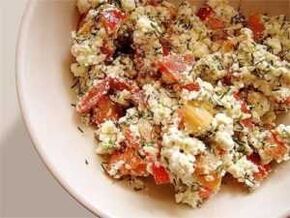
Ingredients:
200 g of cottage cheese, 40 g milk, 1 tomato, 20 g onions, 40 g cucumber, salt, ground cumin.
Preparation:
Peel the tomatoes, remove the seeds from the pulp, peel the onions and cut into thin strips, grate the cucumbers on a coarse grater.
Beat salted cottage cheese with a whisk with milk.
Add all the prepared vegetables to the resulting curd mass, and grind cumin to taste.
Curd snacks
Ingredients:
200 g of cottage cheese, 2 cloves garlic, sesame seeds, salt, green onions, dill, parsley.
Preparation:
Mash the garlic with salt and mix with the cottage cheese. Dilute with water if necessary to form a dense mass. Finely chop the green onions and stir in the sesame seeds. Form rolls of cooked garlic-breast mass, wrap with a mixture of green onions and sesame so that the surface is completely covered. Let the finished rolls cool to harden.
Diet salad for diabetics
Apple and chicken salad
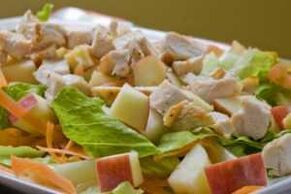
80 g of carrots, 60 g of bean sprouts, 200 g of sour apples, 100 g of cooked chicken breast, salt, 10 g of butter, lemon juice.
Preparation:
Grate the peeled carrots on a coarse grater, wash the apples, remove the core from them, cut into slices, and then into thin strips, just like ready -made chicken.
Mix all the prepared ingredients, add the bean sprouts, salt, sprinkle with oil and lemon juice. Stir well again and let cool.
Five myths about diabetes
Diabetes mellitus is a lifelong chronic disease fraught with complications. People who experience it need to learn to live with it and adjust their rhythm and way of life to it. Despite the fact that this topic is widely discussed in society, there are still many myths about the disease. Let's look at the main ones. So
Myth: diabetes is a disease of obese people.
People rarely recognize the difference between type 1 and type 2 diabetes. Type 1 diabetes can develop during childhood. The disease is genetically determined, there is a need for insulin therapy. In contrast, type 2 diabetes is often associated with being overweight as described above. The disease is characterized by a slow onset.
Myth: Diabetes is a "senile" disease.
Given that there are many obese children and young people today, type 2 diabetes is increasingly affecting younger age groups.
Myth: diabetics should not eat sweets and must adhere to a strict diet.

Diet, of course, is important, but it’s not about eliminating carbohydrates at all. Diabetics should not eat simple sugar (glucose), beet sugar (sucrose) and honey. However, they can use artificial sweeteners. Diabetics should eat complex carbohydrates (starch).
With diabetes mellitus, sweets can only be replaced with sweets-sweeteners, fruits. You can, for example, eat two or three peaches, two oranges or three apples. Or you can eat something made with sweeteners.
Nutritionists recommend preparing sweets at home, this approach ensures that dishes are free of preservatives and harmful additives. From the available and allowed products, you can prepare any special dish, and treat yourself and loved ones with delicious desserts.
Myth: Diabetics can eat well, they just need to eliminate sugar.
As noted, diabetes management involves controlling carbohydrate intake. Complex carbohydrates should be present in the daily diet in equal amounts, as determined by a doctor. The prescribed amount must be distributed throughout the day, as diabetics must eat regularly. The principle of the diabetic diet is consistent with the principle of a balanced diet, so that it not only controls the sugar content, but the overall composition of the diet. The essence of the disease lies not only in metabolic disorders at the level of carbohydrates, but also proteins and fats.
Myth: Diabetics can eat as much fruit as they like.
Fruits contain a number of carbohydrates. Obviously, their content should be included by the diabetic in his daily diet. Therefore, you should not eat fruit in any quantity. It is better to choose a type that contains a minimum amount of carbohydrates and is rich in fiber, which is important for digestion.















































































